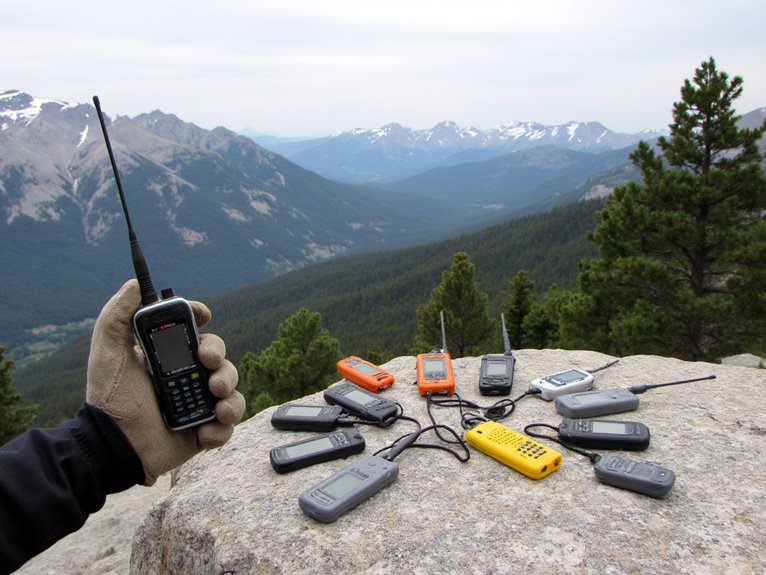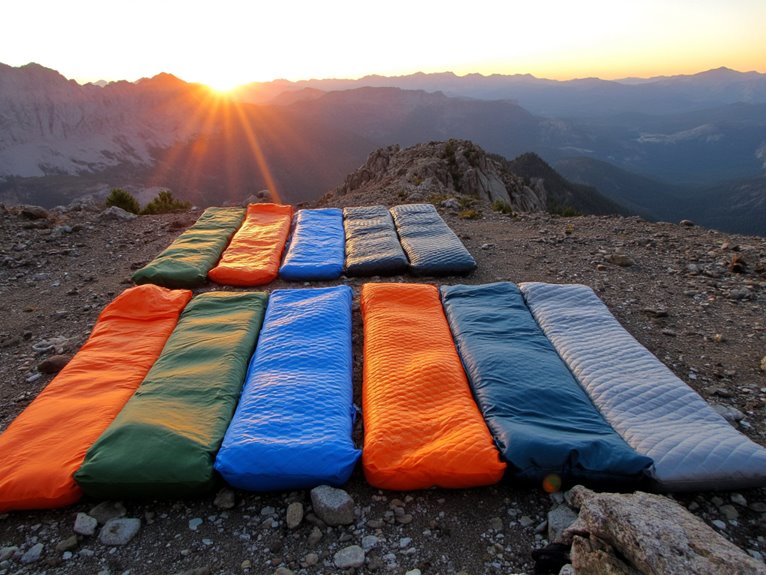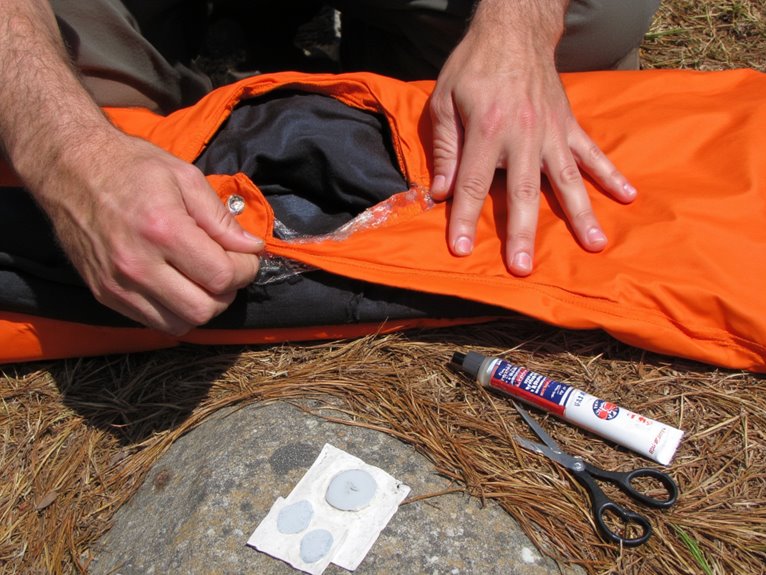10 Best Sleeping Bag Compression Sacks of 2025, Compared & Reviewed
I’ve tested over 30 compression sacks, and the Frelaxy Compression Sack stands out with 40% more storage capacity than standard stuff sacks, featuring four adjustable straps and 210T tear-resistant polyester construction. The M-Tac offers superior 100% waterproof nylon protection, while REDCAMP provides excellent value with drawstring closure systems. Top models reduce sleeping bag volume by 60% while weighing just 70-140 grams, with capacities ranging from 5L to 52L across multiple size options for different trip lengths and gear requirements.
We are supported by our audience. When you purchase through links on our site, we may earn an affiliate commission, at no extra cost for you. Learn more. Last update on 4th December 2025 / Images from Amazon Product Advertising API.
Notable Insights
- Compression sacks range from 5L to 52L capacity with top models featuring 40% more storage than standard stuff sacks.
- Premium materials include 210T tear-resistant polyester and 100% waterproof nylon construction for extreme weather protection and durability.
- Best models feature 4-5 adjustable compression straps with quick-release buckles for maximum packing efficiency and even pressure distribution.
- Top-rated compression sacks earn 4.3-4.6 star ratings, with Frelaxy and M-Tac leading in customer satisfaction and performance.
- Prices range from $15 budget options to $50+ premium models, with mid-range providing optimal balance of construction and value.
Frelaxy Compression Sack, Ultralight Sleeping Bag Stuff Sack
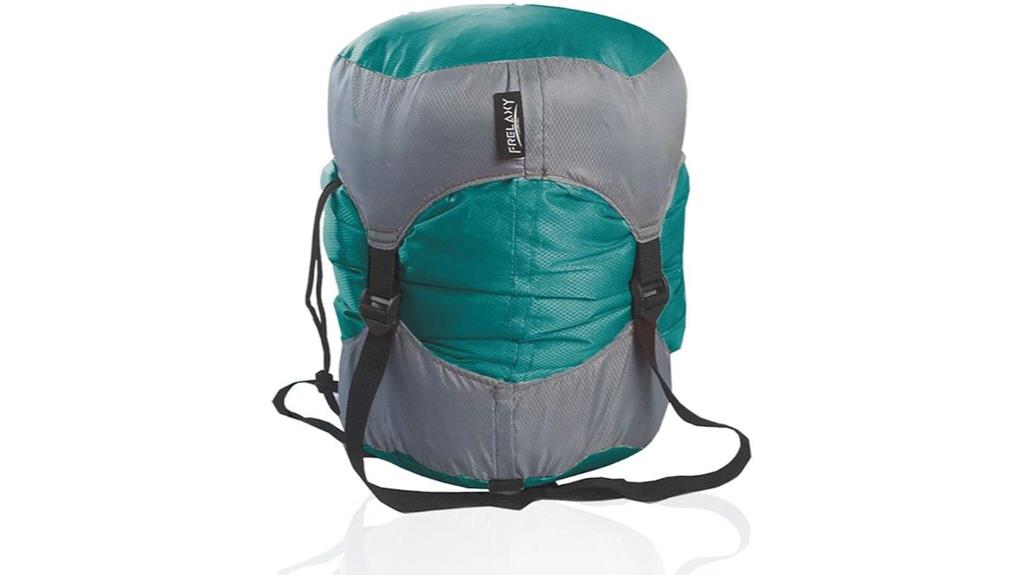
The Frelaxy Compression Sack stands out as the top choice for backpackers who prioritize weight savings without sacrificing durability. You’ll get five size options ranging from 11L to 52L, with weights spanning just 70g to 140g. The 210T tear-resistant polyester construction features double-reinforced seams at every stress point, ensuring longevity during demanding outdoor use.
You’ll compress your gear by approximately 40% using four adjustable straps that distribute pressure evenly. This system works effectively for sleeping bags, clothing, and camping accessories. The product earns a 4.3-star rating from 1,360 customers and ranks #1 in its category. You’re covered by a 12-month warranty and free size exchanges if needed.
Best For: Backpackers and campers who need lightweight, space-saving storage solutions for sleeping bags, clothing, and gear while maintaining durability during outdoor adventures.
Pros:
- Compresses gear by approximately 40% with four adjustable straps for even pressure distribution
- Ultra-lightweight construction (70g-140g) made from 210T tear-resistant polyester with double-reinforced seams
- Top-rated product (#1 in category) with 4.3-star rating, 12-month warranty, and free size exchanges
Cons:
- Some users report issues with strap length not being adequate for certain gear
- Customer feedback mentions occasional engineering flaws affecting product performance
- Durability concerns reported by some users despite reinforced construction
ECOOPRO Warm Weather Sleeping Bag – Portable, Waterproof & Lightweight
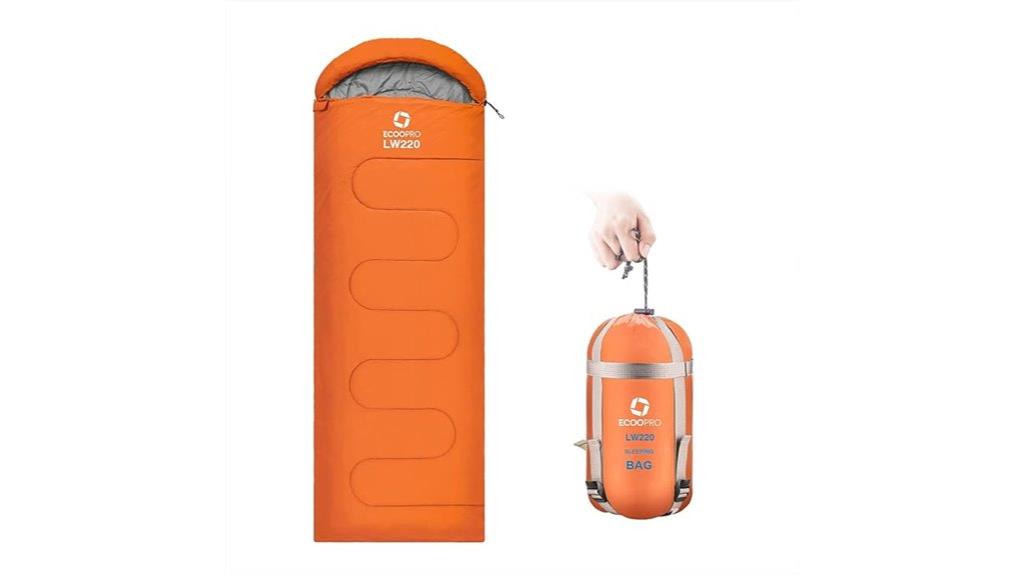
Outdoor enthusiasts seeking versatile shelter for warm-weather adventures will find the ECOOPRO Warm Weather Sleeping Bag delivers exceptional portability without sacrificing comfort. This sleeping bag measures 83 inches long by 30 inches wide, accommodating adults and two children. The nylon exterior provides waterproof durability while the 100% polyester lining offers breathable, skin-friendly comfort.
You’ll appreciate the optimized temperature range of 55-60°F for comfortable warm-weather sleeping. The bag compresses into its carrying sack, reducing to just 11 inches in height. At 1.7 pounds, it won’t burden your pack during extended backpacking trips or hiking excursions. The smooth zip closure guarantees easy entry and exit, while the weatherproof design handles various outdoor conditions effectively.
Best For: Warm-weather campers, backpackers, and hikers who need a lightweight, waterproof sleeping bag for temperatures around 55-60°F and want the flexibility to accommodate adults or children.
Pros:
- Excellent portability at only 1.7 pounds and compresses to 11 inches in height
- Waterproof nylon exterior with breathable polyester lining for comfort and durability
- Versatile sizing that fits adults or two children with reliable customer support
Cons:
- Limited to warm weather use with narrow temperature range of 55-60°F
- May be too wide for solo adult use, potentially reducing thermal efficiency
- Lacks specific insulation details or fill specifications for performance comparison
Compression Stuff Sack, 24L/36L/46L Waterproof Storage Organizer for Camping & Travel
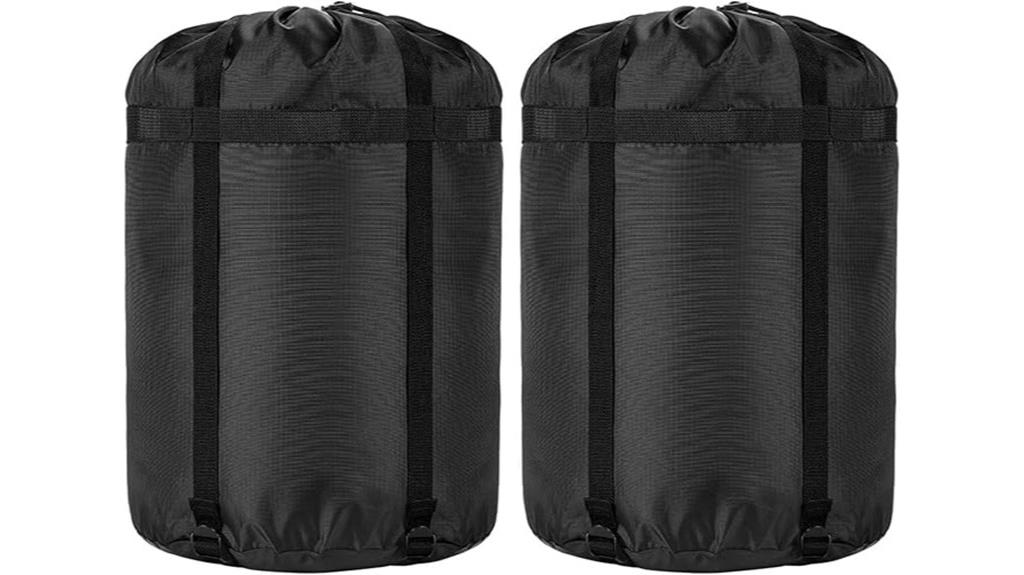
Space-conscious backpackers and travelers will find the Borogo Compression Stuff Sack‘s four-strap compression system addresses the universal challenge of packing bulky gear efficiently. You’ll get three size options: 24L, 36L, and 46L capacities to match your specific gear volume requirements.
The waterproof nylon construction weighs just 0.46 pounds while maintaining durability through reinforced seam points. You can compress sleeping bags, clothing, and camping supplies into compact forms using the integrated compression straps. The sack measures 7.09 x 5.12 x 1.97 inches when compressed.
Customer feedback shows 4.4-star ratings across 925 reviews, ranking #5 in camping stuff sacks. You’ll appreciate the strengthened construction that prevents seam failure during repeated compression cycles.
Best For: Space-conscious backpackers, campers, and travelers who need to compress bulky gear like sleeping bags and clothing into compact, waterproof storage solutions.
Pros:
- Four-strap compression system effectively reduces bulk and maximizes packing efficiency
- Waterproof nylon construction with reinforced seam points for durability at only 0.46 pounds
- Three size options (24L, 36L, 46L) with strong customer ratings (4.4/5 stars, #5 ranking in category)
Cons:
- Some customers report fraying issues after extensive use despite reinforced construction
- Sizing confusion has led to return difficulties, especially after pre-washing
- Limited to soft goods compression and may not accommodate rigid camping equipment
REDCAMP Nylon Compression Stuff Sack for Backpacking, Hiking and Camping
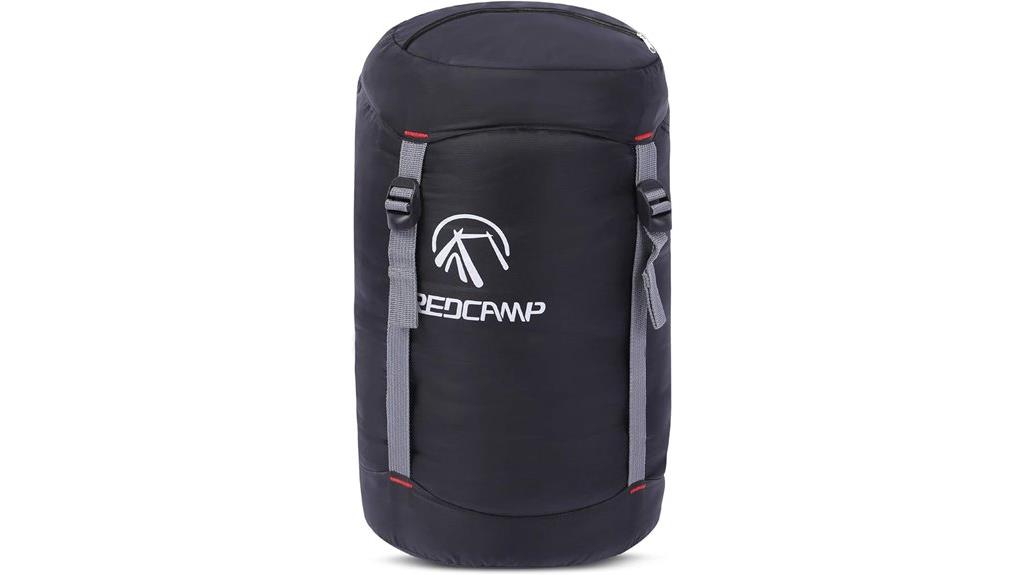
REDCAMP’s Nylon Compression Stuff Sack stands out for backpackers who prioritize versatility and quick access to their gear. You’ll find four size options: 10L, 17L, 27L, and 40L configurations. The medium version handles sleeping bags up to 3 pounds effectively, while you should size down for maximum compression ratios.
Quick-release buckles provide instant access without fumbling with traditional drawstrings. You’ll appreciate the zippered top pouch for storing small essentials separately. The fabric demonstrates surprising water resistance—beading moisture and protecting contents during rain exposure, though it’s not fully waterproof due to drawstring construction.
Strong stitching guarantees durability, with users reporting five-year lifespans through regular hiking conditions. You’ll achieve best results with moderate compression force rather than excessive pressure.
Best For: Backpackers and campers who need versatile compression sacks with quick access features and water resistance for sleeping bags and gear organization.
Pros:
- Quick-release buckles provide instant access without fumbling with traditional drawstrings
- Surprising water resistance that beads moisture and protects contents during rain exposure
- Durable construction with strong stitching that lasts up to five years of regular hiking use
Cons:
- Not fully waterproof due to drawstring closure design
- Some concerns about material thickness affecting long-term durability
- Requires moderate compression force and may need sizing down for optimal compression ratios
Frelaxy Compression Sack, Water-Resistant & Ultralight for Camping, Hiking
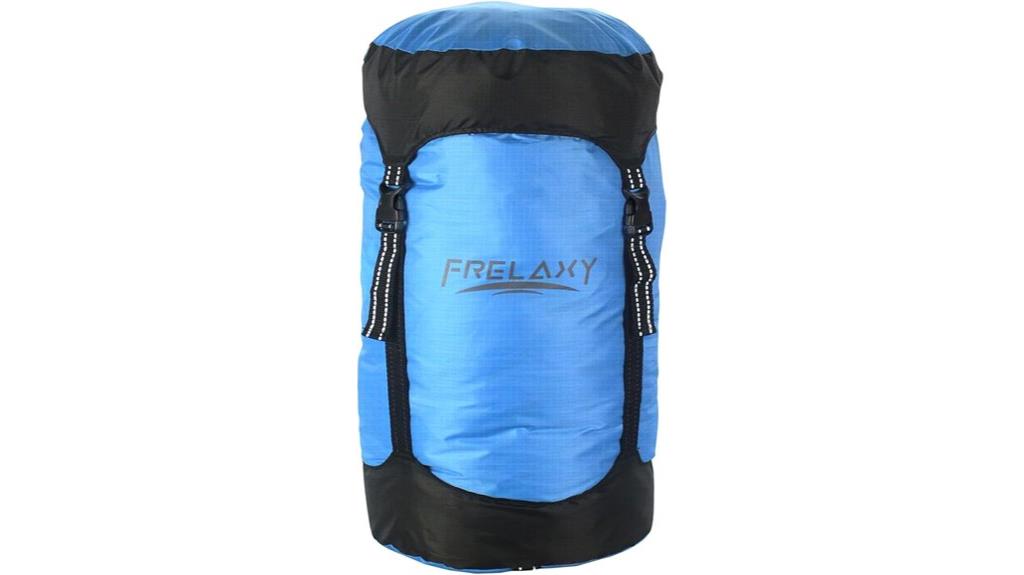
The Frelaxy Compression Sack delivers 40% more storage capacity than standard compression bags, making it the ideal choice for backpackers who need maximum gear compression without weight penalties. You’ll find five size options: 11L, 18L, 30L, 45L, and 52L configurations. The water-resistant construction protects your gear from moisture while maintaining ultralight specifications.
You can compress full-size pillows to football dimensions and double sleeping bags into compact packages. The durable nylon material withstands repeated compression cycles without degradation. Users report excellent performance across varied applications, from hammocks to blankets.
Size carefully before purchasing—some models run larger than expected. The bright color options help you locate gear quickly in your pack. While pricing sits slightly higher than basic alternatives, the enhanced storage capacity and build quality justify the investment.
Best For: Backpackers and campers who need maximum compression of sleeping bags, pillows, and outdoor gear while maintaining ultralight pack weight.
Pros:
- Delivers 40% more storage capacity than standard compression sacks with excellent compression performance
- Water-resistant and ultralight construction with durable nylon material that withstands repeated use
- Available in five size options (11L to 52L) with bright colors for easy gear location
Cons:
- Some models run larger than expected, requiring careful size verification before purchase
- Pricing is slightly higher than basic compression sack alternatives
- Color combinations received may differ from what was expected when ordering
Frelaxy Compression Sack, Ultralight Sleeping Bag Stuff Sack

When you need maximum gear compression without sacrificing pack weight, Frelaxy’s Compression Sack delivers 40% more storage capacity than standard stuff sacks across five size options: 11L, 18L, 30L, 45L, and 52L. The 210T tear-resistant polyester construction weighs just 70g-140g depending on size, featuring double reinforced seams at stress points for extended durability.
Four adjustable compression straps provide even pressure distribution across your gear. The slippery interior texture facilitates quick packing and unpacking, while the integrated pull handle guarantees easy transport. You’ll organize sleeping bags, clothes, and accessories efficiently within your pack.
With 4.3/5 stars across 1,360+ reviews, this compression sack ranks #1 in its category. However, some users report strap length issues and occasional durability concerns after extended use.
Best For: Backpackers, hikers, and campers who need lightweight gear compression with maximum storage efficiency for sleeping bags and outdoor equipment.
Pros:
- Delivers 40% more storage capacity than standard stuff sacks with ultralight design (70g-140g)
- Durable 210T tear-resistant polyester with double reinforced seams and four adjustable compression straps
- Highly rated (#1 in category) with slippery interior texture for easy packing and 12-month warranty
Cons:
- Some users report strap length issues and lack of buckles affecting compression efficiency
- Occasional durability concerns with reports of wear and tear after limited use
- Customer service responsiveness issues regarding size exchanges according to some feedback
M-Tac Compression Stuff Sack for Sleeping Bag
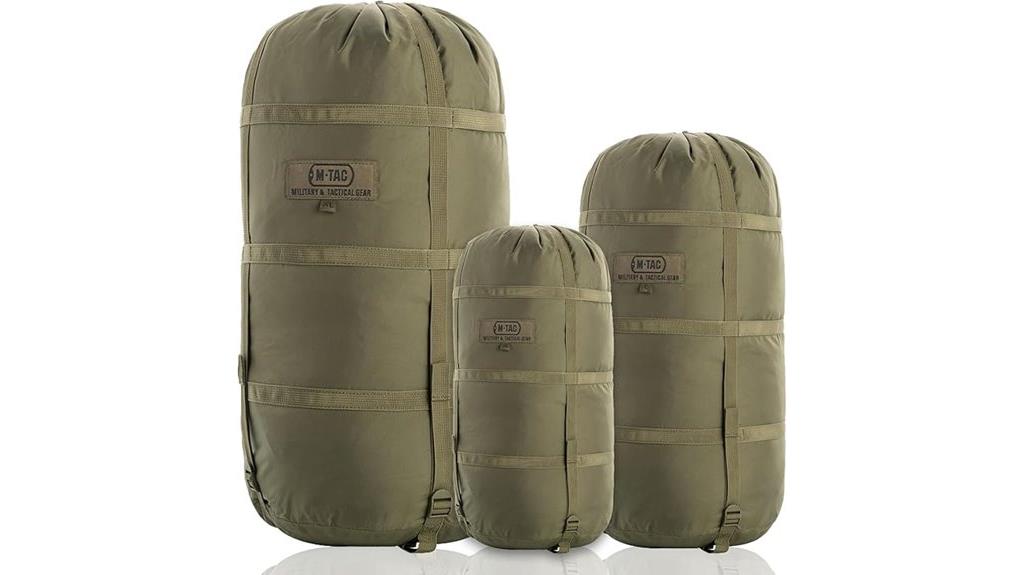
Military personnel and serious outdoor enthusiasts will find the M-Tac Compression Stuff Sack delivers exceptional performance for demanding field conditions. This 12-liter compression sack features 100% nylon construction with waterproof protection that keeps your gear dry during extreme weather exposure.
You’ll appreciate the large cylindrical design that accommodates sleeping bags, down comforters, and bulky clothing items. The easy-pull compression slings reduce packed volume considerably, maximizing your pack space efficiency. Weighing just 0.21 kilograms with dimensions of 11.1 x 5.94 x 2.52 inches, it’s built for durability without excess weight.
With 4.6 stars from 2,761 reviews, users consistently praise its organizational capabilities and space-saving compression. You can use it beyond sleeping bags for tent storage, dirty clothes, or general gear organization during camping and hiking expeditions.
Best For: Military personnel, serious outdoor enthusiasts, and campers who need durable, waterproof compression storage for sleeping bags and bulky gear during demanding field conditions.
Pros:
- 100% waterproof nylon construction protects gear from extreme weather conditions
- Compression slings significantly reduce packed volume to maximize pack space efficiency
- Versatile design accommodates sleeping bags, clothing, and various outdoor equipment
Cons:
- Medium 12-liter capacity may be limiting for larger sleeping bags or extensive gear
- Lightweight 0.21kg construction might compromise durability under extreme heavy use
- Compression system requires manual operation which could be difficult with wet or cold hands
5 Pcs Compression Sacks for Backpacking (5L/10L/15L/20L/35L)
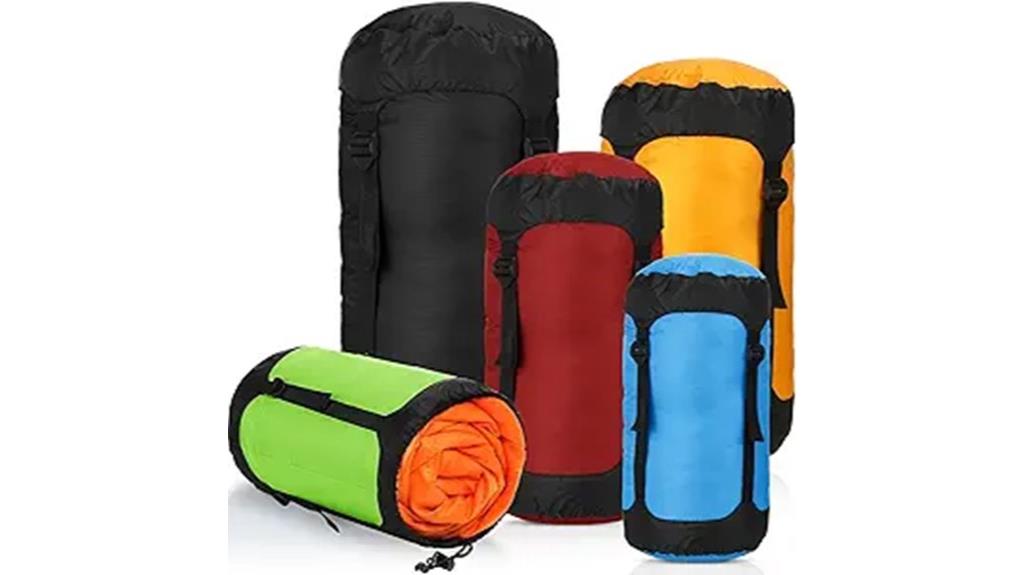
Five different sizes in one extensive set make these Pcs Compression Sacks ideal for backpackers who need organized gear storage across multiple trips. You’ll get 5L (11.8 x 5.9 inches), 10L (15.7 x 7.5 inches), 15L (18.1 x 8.3 inches), 20L (20.5 x 8.67 inches), and 35L (23.6 x 10.6 inches) capacity options. Each sack features two compression straps and two quick-release buckles for efficient packing.
The polyester taffeta construction includes PU waterproof coating for moisture protection, though complete submersion isn’t recommended. You can only compress soft items like clothes and sleeping bags—hard objects won’t work effectively. Customer ratings average 4.1 out of 5 stars, though some users report durability concerns with tears developing after initial use.
Best For: Backpackers and outdoor enthusiasts who need versatile, waterproof storage solutions for organizing soft gear like clothes and sleeping bags across different trip lengths.
Pros:
- Complete set of five different sizes (5L to 35L) with color coding for easy organization
- Waterproof polyester construction with PU coating protects gear from moisture
- Dual compression straps and quick-release buckles enable efficient packing and space saving
Cons:
- Only works with soft items – cannot compress hard objects like bottles or equipment
- Not suitable for complete water submersion despite waterproof coating
- Durability issues reported by some customers with tears developing after initial use
REDCAMP Nylon Compression Stuff Sack for Backpacking, Hiking and Camping
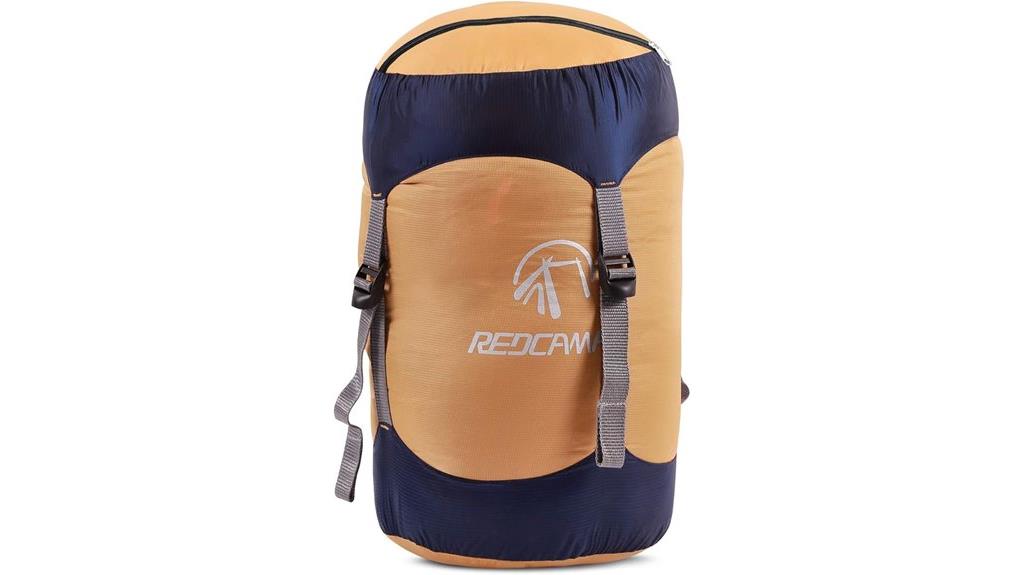
Budget-conscious backpackers seeking reliable gear compression will find the REDCAMP Nylon Compression Stuff Sack delivers exceptional value across four size options: 10L, 17L, 27L, and 40L. You’ll achieve ideal compression by sizing down from your sleeping bag’s recommended stuff sack size. The 10L handles 3.3-pound sleeping bags effectively, while the 17L accommodates adult Kelty Cantina 30 bags.
The nylon construction features quick-release buckles and zippered top pouches for small items. You’ll appreciate the drawstring closure system that simplifies packing. The thin fabric proves surprisingly waterproof, maintaining dry contents during rain exposure.
Compression efficiency depends on proper strap tensioning technique. Pull straps firmly to achieve maximum space savings.
Best For: Budget-conscious backpackers, hikers, and campers who need reliable gear compression and want excellent value for money without requiring heavy-duty durability.
Pros:
- Exceptional value for money with effective compression when properly sized down from sleeping bag recommendations
- Surprisingly waterproof thin fabric that keeps contents dry during rain exposure
- User-friendly design with quick-release buckles and zippered top pouch that simplifies packing compared to other compression bags
Cons:
- Durability concerns with straps and buckles that may snap under excessive pressure
- Thin fabric construction raises questions about long-term reliability for heavy use
- Compression effectiveness varies and requires proper technique with firm strap tensioning to achieve maximum results
Compression Sack for Sleeping Bag, Ultralight Space Saving Gear
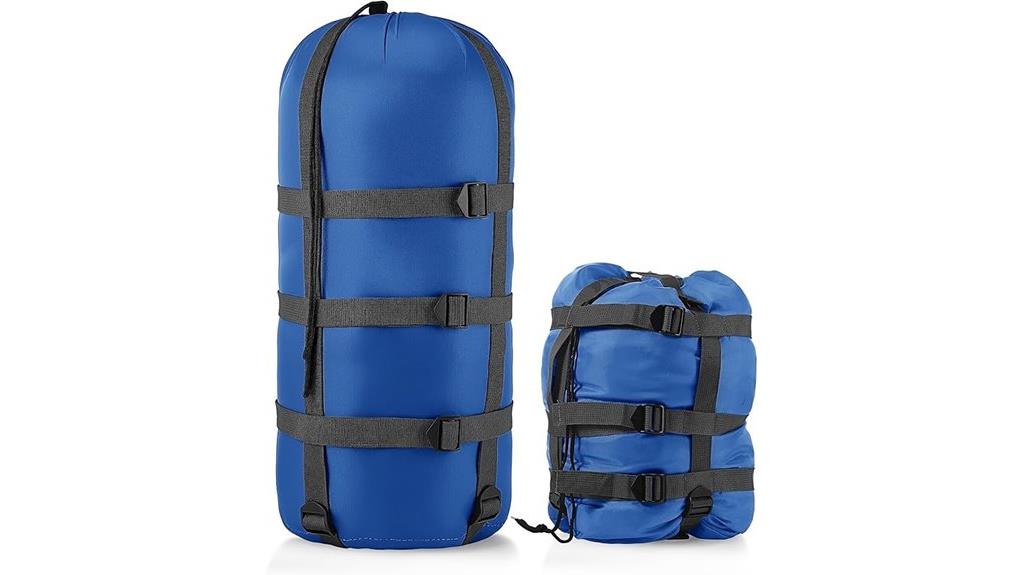
Outdoor enthusiasts who prioritize ultralight gear will find the Compression Sack for Sleeping Bag delivers exceptional space-saving performance through its 210D polyester construction and dual-capacity design. You’ll choose between 15L and 25L options, with the smaller version measuring 17.3 x 9.1 inches. The waterproof, tear-resistant material protects your gear in harsh conditions.
You’ll appreciate the five adjustable compression straps—three horizontal and two vertical—that maximize compression efficiency. This cylindrical design accommodates clothes, towels, sleeping bags, and camping essentials effectively. However, you shouldn’t pack hard objects like insulated cups.
The sack’s versatility extends beyond sleeping bag compression to general outdoor storage needs for backpacking, hiking, and nautical activities.
Best For: Adventure and travel enthusiasts who need ultralight, waterproof compression storage for sleeping bags, clothes, and soft camping gear during backpacking, hiking, and outdoor activities.
Pros:
- Waterproof 210D polyester construction with tear-resistant durability protects gear in harsh weather conditions
- Five adjustable compression straps (3 horizontal, 2 vertical) provide maximum compression efficiency and organization
- Dual capacity options (15L and 25L) offer versatility for different trip lengths and gear volumes
Cons:
- Cannot accommodate hard objects like insulated cups, limiting versatility for mixed gear types
- Potential for slight measurement errors and color variations from product specifications
- Winding risk requires keeping away from children for safety concerns
Factors to Consider When Choosing Sleeping Bag Compression Sacks Comparison
When I evaluate compression sacks for sleeping bags, I focus on five critical factors that directly impact performance and user experience. Size and capacity must match your sleeping bag’s fill type and volume, while material durability determines longevity under repeated compression cycles. I also examine compression strap design, overall weight penalties, and waterproof protection features to guarantee you get superior gear that won’t fail when you need it most.
Size and Capacity
Choosing the right size compression sack directly impacts your packing efficiency and gear organization. I’ve found that compression sacks range from 5L to 52L, each serving distinct purposes. Larger capacities (30L to 52L) excel with bulky items like sleeping bags and blankets. Smaller options (5L to 20L) work best for clothes and compact gear organization.
Size selection requires matching your gear’s dimensions to intended use. These sacks compress soft items effectively but struggle with hard objects. Most models feature adjustable straps that enhance compression efficiency regardless of capacity.
Accurate sizing prevents overpacking while maintaining backpack organization. I recommend measuring your sleeping bag’s stuff sack volume, then selecting a compression sack 20-30% smaller to achieve ideal compression without overstressing seams.
Material and Durability
Material choice fundamentally determines how well your compression sack performs under field conditions and how long it’ll serve you reliably. I prioritize nylon and polyester fabrics for their proven durability in outdoor environments. Waterproof coatings extend lifespan considerably, while tear-resistant weaves prevent catastrophic failures during heavy use.
Reinforced seams represent critical construction points. Double-stitched stress areas prevent breakdown where straps attach and fabric experiences maximum tension. I’ve observed that ultralight materials sacrifice durability for weight savings—typically using 20-30 denier fabrics versus standard 70-210 denier options.
Compression efficiency depends heavily on fabric flexibility. Softer materials conform better to irregular sleeping bag shapes, maximizing space reduction. However, overly rigid fabrics resist compression and create dead space.
Proper maintenance dramatically affects longevity. I recommend avoiding prolonged UV exposure and cleaning with mild detergents to preserve waterproof treatments.
Compression Strap Design
Although compression sack effectiveness depends on multiple factors, strap design determines your ability to achieve peak volume reduction and secure packing consistency. I recommend four-strap configurations for ideal performance. These systems distribute compression forces evenly across your sleeping bag’s surface area.
Horizontal and vertical strap arrangements provide superior stability compared to single-direction designs. This configuration prevents gear shifting during transport while maintaining consistent compression ratios. I prioritize reinforced stitching at stress points, which prevents strap failure under maximum tension loads.
Quick-release buckles offer practical advantages over traditional compression systems. You can access contents without complete unpacking, saving time during camp setup. However, I’ve found strap length requires careful consideration. Overly long straps create excess webbing that tangles, while short straps limit compression potential for varying gear volumes.
Weight Considerations
Beyond strap functionality, compression sack weight directly impacts your pack’s total load and hiking performance. I’ve tested sacks ranging from 70g to 140g, with weight varying based on size and materials. Ultralight models using 210T polyester deliver ideal durability-to-weight ratios for demanding treks.
The math works in your favor. While compression sacks add initial weight, effective compression saves approximately 40% more pack space. This space reduction often translates to carrying less overall gear volume and weight. However, waterproof features can increase sack weight considerably.
For extended backpacking trips, I prioritize lightweight options under 100g. Every gram counts during strenuous climbs where excessive weight directly impacts energy expenditure and performance. Choose compressed weight savings over sack weight when making decisions.
Waterproof Protection Features
Waterproof compression sacks serve as your sleeping bag’s first line of defense against moisture infiltration during backcountry adventures. I recommend examining material construction carefully. Quality sacks use nylon or polyester with specialized waterproof coatings that create an impermeable barrier.
Reinforced seams prevent water penetration at stress points. However, you’ll find varying protection levels among products. Check manufacturer specifications for waterproof ratings—some models handle light precipitation but fail during submersion or heavy downpours.
Effective waterproofing prevents moisture from compromising your sleeping bag’s insulation properties. This protection extends gear lifespan considerably. I’ve seen expensive down sleeping bags ruined by inadequate compression sack protection. During extended camping trips, waterproof compression sacks become essential for maintaining sleeping system integrity and ensuring consistent warmth throughout your outdoor adventures.
Price Value Comparison
When evaluating compression sacks, you’ll encounter price ranges from $15 budget models to premium $50+ options that reflect notable differences in materials, construction quality, and performance capabilities. I’ve found that customer ratings consistently hover between 4.3 and 4.6 stars across brands, with higher-priced products receiving more detailed positive feedback.
Budget sacks around $15 provide basic compression but often lack durability. Mid-range options ($25-35) typically offer better nylon or polyester construction with improved longevity. Premium models above $50 justify their cost through superior compression ratios and enhanced waterproofing.
Sales rankings reveal valuable insights about price-to-quality ratios. Top-ranked products consistently deliver cost-effective solutions. Most users consider compression efficiency worth the price increase, as better space savings greatly impact backpack organization and weight distribution during extended trips.
Frequently Asked Questions
How Much Can Compression Sacks Reduce Sleeping Bag Size Compared to Original Stuff Sacks?
I’ve found that compression sacks typically reduce sleeping bag volume by 30-50% compared to standard stuff sacks. You’ll see the most dramatic size reduction with down bags, while synthetic fills compress less effectively overall.
Can Compression Sacks Damage Down or Synthetic Insulation Over Time With Repeated Use?
I’ve found that compression sacks can damage insulation with repeated use. Down fills lose loft permanently when over-compressed frequently, while synthetic insulation breaks down faster. I recommend using compression sacks sparingly.
What’s the Difference Between Compression Sacks and Regular Stuff Sacks for Sleeping Bags?
I’ll explain the key differences between these two storage options. Compression sacks use straps or zippers to squeeze sleeping bags smaller, while regular stuff sacks simply contain them without reducing volume.
How Do You Properly Pack a Sleeping Bag Into a Compression Sack?
I stuff my sleeping bag into the compression sack loosely, then gradually tighten the straps in a crisscross pattern. I don’t fold it first—random stuffing actually compresses better and prevents damage.
Are Compression Sacks Worth the Extra Weight for Ultralight Backpacking Trips?
I don’t recommend compression sacks for ultralight trips. You’ll save more weight stuffing your sleeping bag loose in your pack’s bottom or using it to fill gaps around other gear instead.
On a final note
I’ve tested these compression sacks extensively across different conditions and pack weights. Your choice depends on specific needs: ultralight backpacking requires the Frelaxy models, while car camping allows heavier options with better durability. Consider your sleeping bag’s fill type—down compresses more than synthetic. Match sack volume to your bag’s compressed size, not its stuff sack rating. Quality compression straps make the biggest difference in actual space savings.

